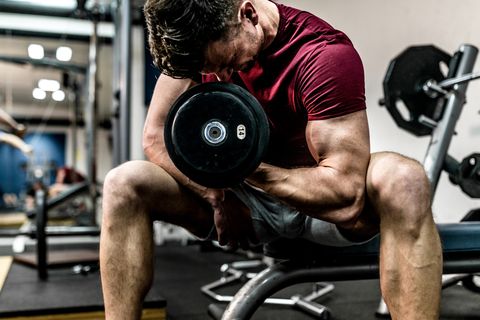There are a ton of mistakes you can make when training for an obstacle course race of course. It can be hard to boil it down to just 4. So I thought I would talk specifically about your strength training and talk about a few that I rarely see people talk about.
I think I can skip the part about where we talk about why you should be strength training. Building strength seems to be a well practiced area of training in the OCR community. But it is important to remember the purpose behind why you are training this way.
You want to get strong for a few reasons. It will help reduce your risk of injuries since your body will be able to handle more stress placed on it and you want ot have the strength capacity to be able to overcome obstacles. Keep these in mind when putting together your strength routines. These mistakes will directly interfere with these goals.
So let’s get into a few of the mistakes.
Focusing on Muscles Not Movements
 I am surprised we still need to mention this one, but I see it over and over again. When people put programs together you still see those old body building workouts hanging around. This would be something like Monday is Chest and Biceps, Tuesday is Back and Triceps, etc.
I am surprised we still need to mention this one, but I see it over and over again. When people put programs together you still see those old body building workouts hanging around. This would be something like Monday is Chest and Biceps, Tuesday is Back and Triceps, etc.
There a few reasons you want to avoid this type of training. The biggest one is, it is just not functional. Your body doesn’t like to isolate muscles or body parts. Take a bicep curl for example. Is your bicep the only thing really working? Of course not. Your entire posterior chain is engaged so the weight doesn’t pull you over.
Think when in real life or in a race will you ever use a single muscle or body part? Never. This type of workout is good for building muscle size, but does not help much for performance or functional tasks. So just stop doing it.
The other reason is, you don’t want to be strength training every day. For the purposes of OCR you are good with 2-3 days per week with total body routines. You need other days to focus on other areas of training like running and obstacle work.
Plus, if you hit one body part each day of the week that means you are only training that area once per week. If you perform total body training, you may not beat up each muscle as much but you will hit it multiple times every week.
So instead organize total body movement patterns for each workout. Focus on things like squatting, lunging, hip hinging, pushing, and pulling. We can break these down more, but just make sure you hit at least one movement per category each workout. Then every day is leg day which is awesome.
It is ok to throw in a few isolation type exercises. There is nothing wrong with wanting bigger arms or other area of the body. Just make these secondary exercises.
Changing Your Routine Every Workout
 Unfortunately 90X invented a term that caught on for many. The idea of muscle confusion. They literally made up this term. The idea is that you have to keep changing up your exercise to confuse your muscles so you get better results. At least I think that is the thought.
Unfortunately 90X invented a term that caught on for many. The idea of muscle confusion. They literally made up this term. The idea is that you have to keep changing up your exercise to confuse your muscles so you get better results. At least I think that is the thought.
Even if this were true really the only benefit would be to burn more calories in each workout. If you are trying to lose weight, you can argue for something like this. But if you are trying to get stronger and race better, this is not the way to go.
You need to follow a similar routine to master the movements and see real progress. Otherwise, how would you even know you are getting stronger?
Imagine you wanted to learn the guitar and the first lesson the instructor taught you the E and G chords. By the end of the lesson you could get them pretty good. Then the next lesson they forgot about those chords and only showed you the A and C. Then the next lesson the F and D. How good would you get at playing the guitar? How’s that E and G chord coming?
You would get frustrated and never learn how to really play. Training is the same way. You need repetition and consistency. You can and should change things up, but it should be part of a master plan. This is how you really see your strength improve. Avoid doing something new every single time you train.
Using Grip Straps
Grip straps have their place in training, but I think it should be a very rare occurrence. If you need to use a grip strap, what is it telling you? That your limiting factor is your grip. Now if you are trying to lift the heaviest amount of weight possible for a specific reason like a competition, that is one thing.
But for the purposes of OCR, we know how important grip strength is. Why not take every opportunity to train it. Sure this might mean you aren’t lifting as heavy as you could with straps, but that is ok.
This if more functional strength. It is training for strength in the real world. Most likely during a race or walking down the street you won’t put on straps before picking something up. You want the raw strength to just be able to do it.
You truly get stronger when your weakest link get stronger. Not just your strongest piece.
Using Gloves
 This may be repetitive, but I thought it was still worth bringing up. You may not use straps, but you might use workout gloves for your training. This is a similar idea. If you are using gloves to lift more or grip better, it is telling you what your weakest link is. I will even throw chalk into the mix here. I more so just hate chalk because it is a mess to clean up at our studio, but I will save that rant for another day.
This may be repetitive, but I thought it was still worth bringing up. You may not use straps, but you might use workout gloves for your training. This is a similar idea. If you are using gloves to lift more or grip better, it is telling you what your weakest link is. I will even throw chalk into the mix here. I more so just hate chalk because it is a mess to clean up at our studio, but I will save that rant for another day.
There is a reason your hands get beat up from this type of training. And if your hands aren’t ready for the work, the rest of your body probably isn’t either. Your grip just won’t get as strong if you constantly are wearing gloves in your training.
Now, if you are use to gloves, I wouldn’t just throw them away. Just pick a few workouts each week not to wear them. That way your hands still can get a break and heal from the previous workout so you can still get a workout out. I’m also not saying you shouldn’t be using gloves during a race. Certain types of gloves on certain obstacles may make a huge difference for you. But, the focus on your training is to get your hands strong.
You may not be going for the strong hands look, but it will make a huge difference in your obstacles.
Hopefully these give you a few ideas on how you can improve your strength training. If you want to see a sample program I use to help athletes see the best way to put their training together click the link below and download my Free Jumpstart Training Program.
Mike Deibler MS, CSCS, SGX
OCR Underground Podcast
Fuel and Fire Mentorship Training

